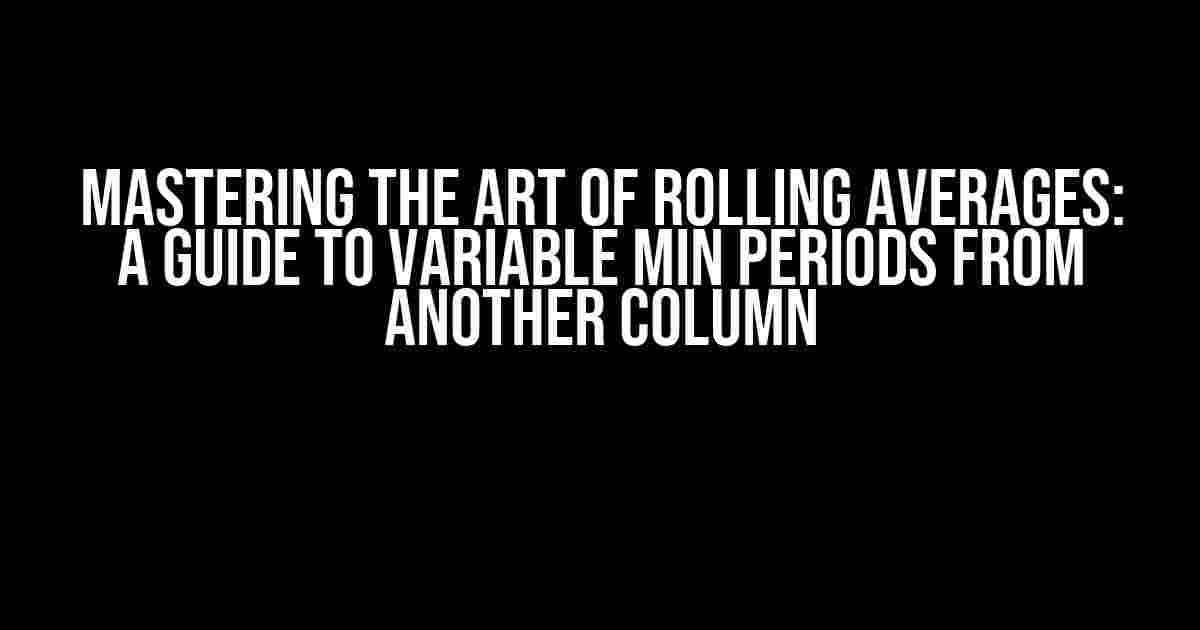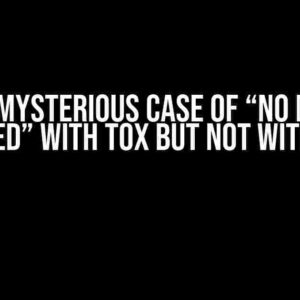Are you tired of static rolling averages that don’t adapt to changing data landscapes? Do you want to take your data analysis to the next level by incorporating dynamic minimum periods from another column? Look no further! In this comprehensive guide, we’ll delve into the world of rolling averages with variable min periods, empowering you to make data-driven decisions like a pro.
What is a Rolling Average?
A rolling average, also known as a moving average, is a statistical measure that calculates the average value of a set of data points over a specified window of time. It’s a powerful tool for smoothing out fluctuations, identifying trends, and making forecasts. Traditionally, rolling averages have fixed window sizes, but what if you want to adjust the window based on another column in your dataset? That’s where variable min periods come into play.
The Power of Variable Min Periods
By incorporating variable min periods from another column, you can dynamically adjust the rolling average window size based on specific conditions or thresholds. This approach allows you to:
- Account for seasonality and anomalies in your data
- Respond to changes in market trends or user behavior
- Optimize resource allocation and planning
- Enhance forecasting accuracy and reduce errors
Setting Up Your Data
To get started, you’ll need a dataset with at least two columns: the column you want to calculate the rolling average for (e.g., sales, temperatures, etc.) and the column that will determine the min periods (e.g., date, category, etc.). Let’s assume we have a DataFrame `df` with the following structure:
+---------+---------+---------+ | date | sales | category | +=========+=========+=========+ | 2022-01 | 100 | A | +---------+---------+---------+ | 2022-02 | 120 | A | +---------+---------+---------+ | 2022-03 | 110 | B | +---------+---------+---------+ | 2022-04 | 130 | B | +---------+---------+---------+ | ... | ... | ... | +---------+---------+---------+
Calculating Rolling Averages with Variable Min Periods
Now, let’s dive into the code! We’ll use the `rolling` function from pandas to calculate the rolling average, and the `min_periods` parameter to specify the dynamic window size. We’ll also use the `np.where` function to conditionally adjust the `min_periods` based on the values in the `category` column.
import pandas as pd
import numpy as np
# define the rolling average window size based on category
min_periods_dict = {'A': 2, 'B': 3}
# create a new column for the rolling average
df['rolling_avg'] = df.groupby('category')['sales'].apply(lambda x: x.rolling(window=np.where(x.index.isin(x.index[:-min_periods_dict[x.name]]), min_periods_dict[x.name], 1), min_periods=1).mean())
In this example, we’re grouping the data by `category` and applying the rolling average function to each group. The `np.where` function checks if the current index is within the specified `min_periods` range for each category, and adjusts the `min_periods` accordingly. The `rolling` function then calculates the average over the dynamic window size.
Visualizing the Results
Let’s visualize the results to better understand the impact of variable min periods on our rolling average. We’ll use a line plot to display the original sales data and the rolling average.
import matplotlib.pyplot as plt plt.plot(df['sales'], label='Sales') plt.plot(df['rolling_avg'], label='Rolling Avg') plt.legend() plt.show()
This plot illustrates how the rolling average adapts to changes in the `category` column, using a shorter window size for category A and a longer window size for category B.
Tuning and Refining
As with any data analysis, it’s essential to tune and refine your approach to ensure accurate and meaningful results. Consider the following adjustments:
- Experiment with different `min_periods` values to balance smoothing and adaptability
- Apply weightings or exponential smoothing to emphasize recent data
- Incorporate additional columns or features to enhance forecasting capabilities
- Use other rolling average variants, such as the exponentially weighted moving average (EWMA)
Common Pitfalls and Solutions
When working with rolling averages and variable min periods, be aware of the following potential pitfalls:
| Pitfall | Solution |
|---|---|
| Data Insufficiency | Collect more data or consider alternative methods, such as interpolation or imputation |
| Over-Smoothing | Decrease the `min_periods` value or experiment with different rolling average variants |
| Under-Smoothing | Increase the `min_periods` value or apply additional smoothing techniques |
| Non-Stationarity | Detrend or difference the data to stabilize the mean, or use techniques like seasonal decomposition |
Conclusion
By mastering the art of rolling averages with variable min periods from another column, you’ve unlocked a powerful tool for data analysis and forecasting. Remember to adapt your approach to your specific use case, and don’t be afraid to experiment and refine your methods. With practice and patience, you’ll be able to tame even the most complex data landscapes.
Now, go forth and conquer the world of data analysis with your newfound skills!
Frequently Asked Question
Get ready to roll with the answers to your burning questions about rolling averages with variable min_periods from another column!
What is a rolling average, and why do I need it?
A rolling average, also known as a moving average, is a calculation that takes the average of a fixed number of data points, and then moves forward to calculate the average of the next set of data points. You need it to smooth out fluctuations in your data, identify trends, and make predictions. In this case, we’re taking it to the next level by using a variable min_periods from another column!
How do I implement a rolling average with a variable min_periods from another column in Python?
You can use the rolling function from the pandas library in Python. The trick is to pass a Series with the variable min_periods as the window parameter. For example: `df[‘rolling_avg’] = df[‘values’].rolling(window=df[‘min_periods’]).mean()`. This will calculate the rolling average with the min_periods specified in the ‘min_periods’ column.
What if I want to apply a rolling average to multiple columns with different min_periods?
You can use the apply function to apply the rolling average to multiple columns. For example: `df[[‘col1’, ‘col2’, ‘col3’]] = df.apply(lambda x: x.rolling(window=x[‘min_periods’]).mean(), axis=0)`. This will apply the rolling average with the min_periods specified in the ‘min_periods’ column to each of the specified columns.
How do I handle NaN values in my data when calculating the rolling average?
You can use the min_count parameter of the rolling function to specify the minimum number of non-NaN values required to calculate the rolling average. For example: `df[‘rolling_avg’] = df[‘values’].rolling(window=df[‘min_periods’], min_count=1).mean()`. This will ignore NaN values and only calculate the rolling average when there is at least one non-NaN value.
Can I use a rolling average with a variable min_periods from another column in other programming languages?
Yes, you can! While the implementation details may vary, most programming languages have libraries or functions that support rolling averages with variable window sizes. For example, in R, you can use the zoo and rollapply functions. In SQL, you can use window functions like ROWS or RANGE to achieve similar results.



